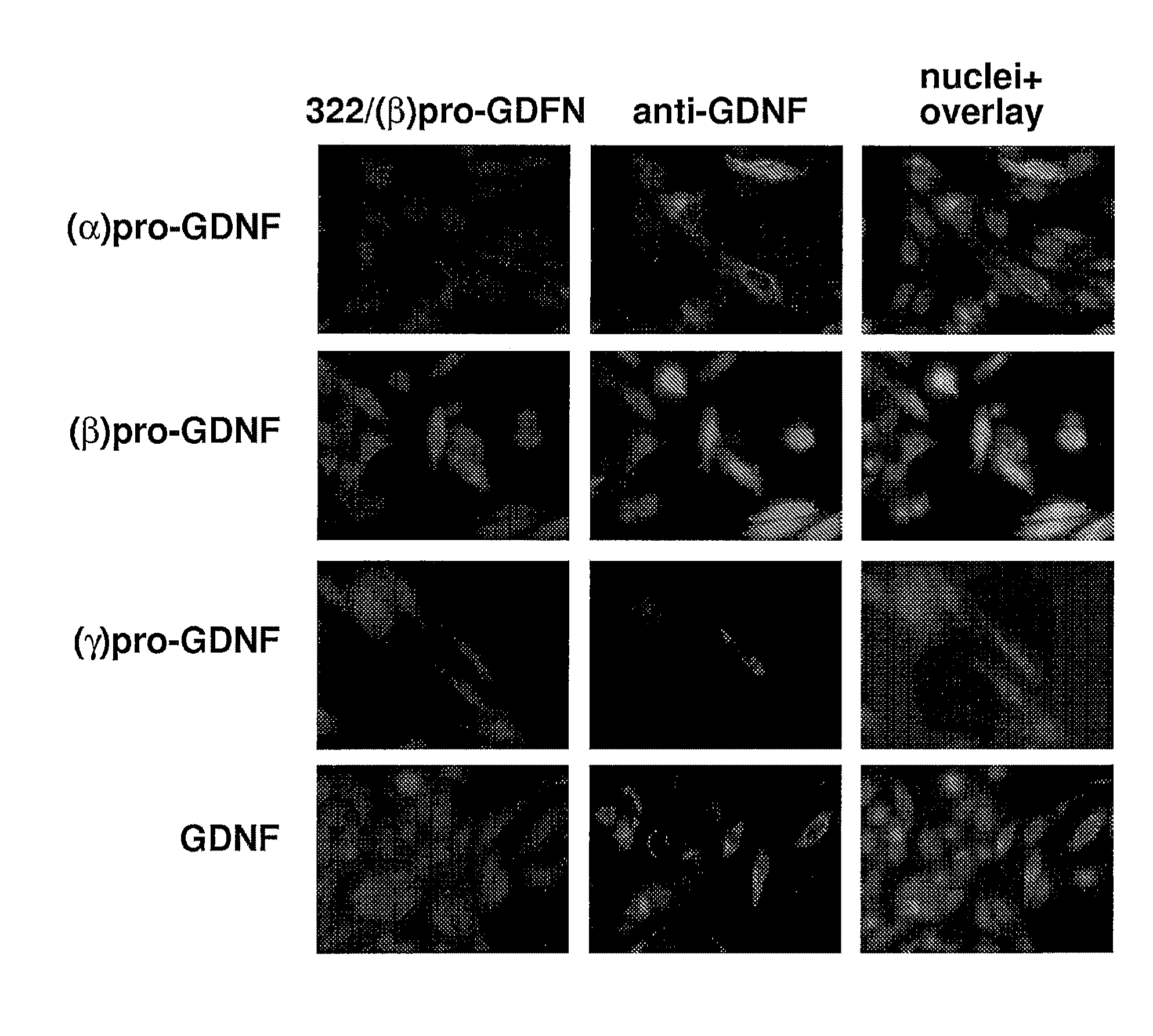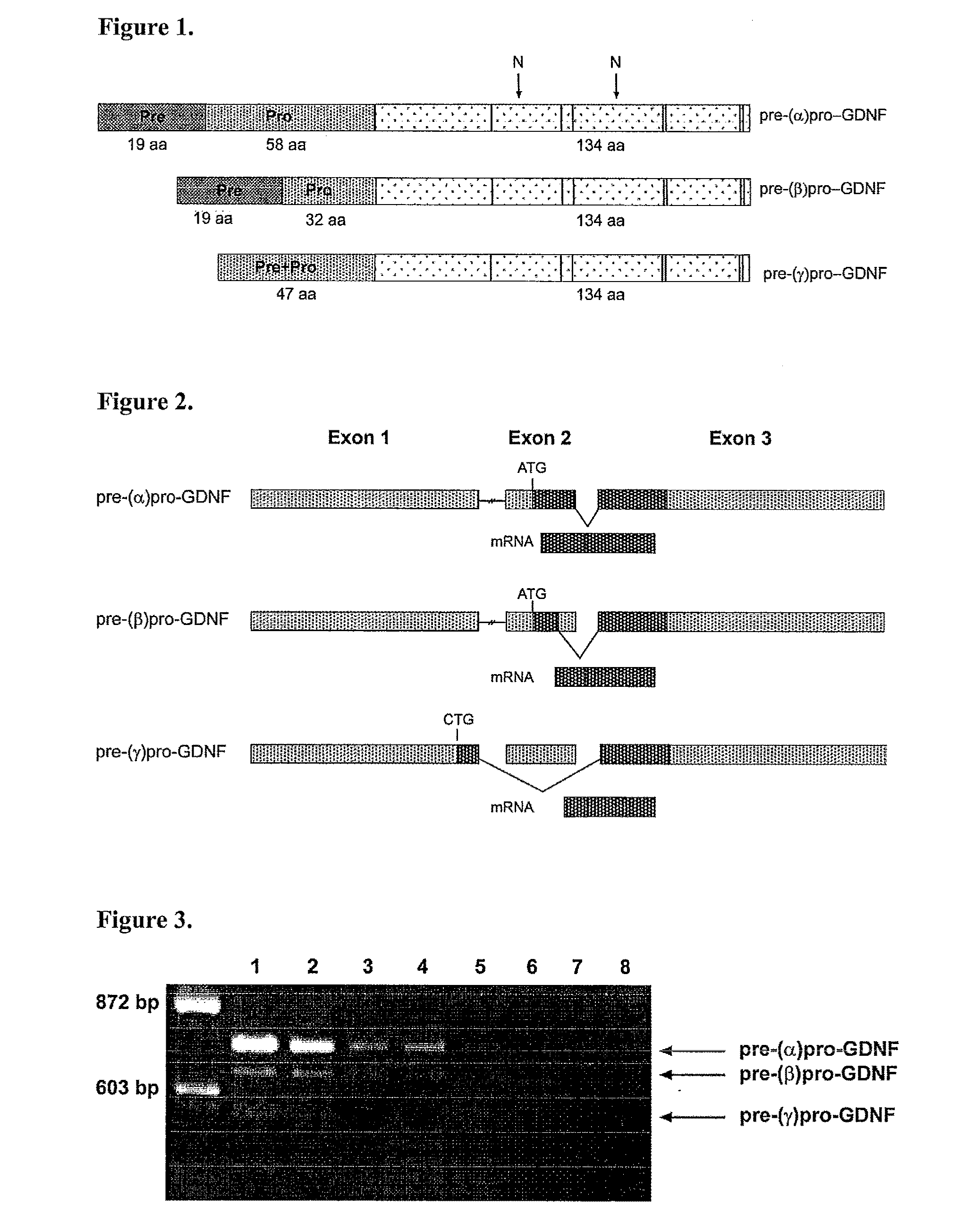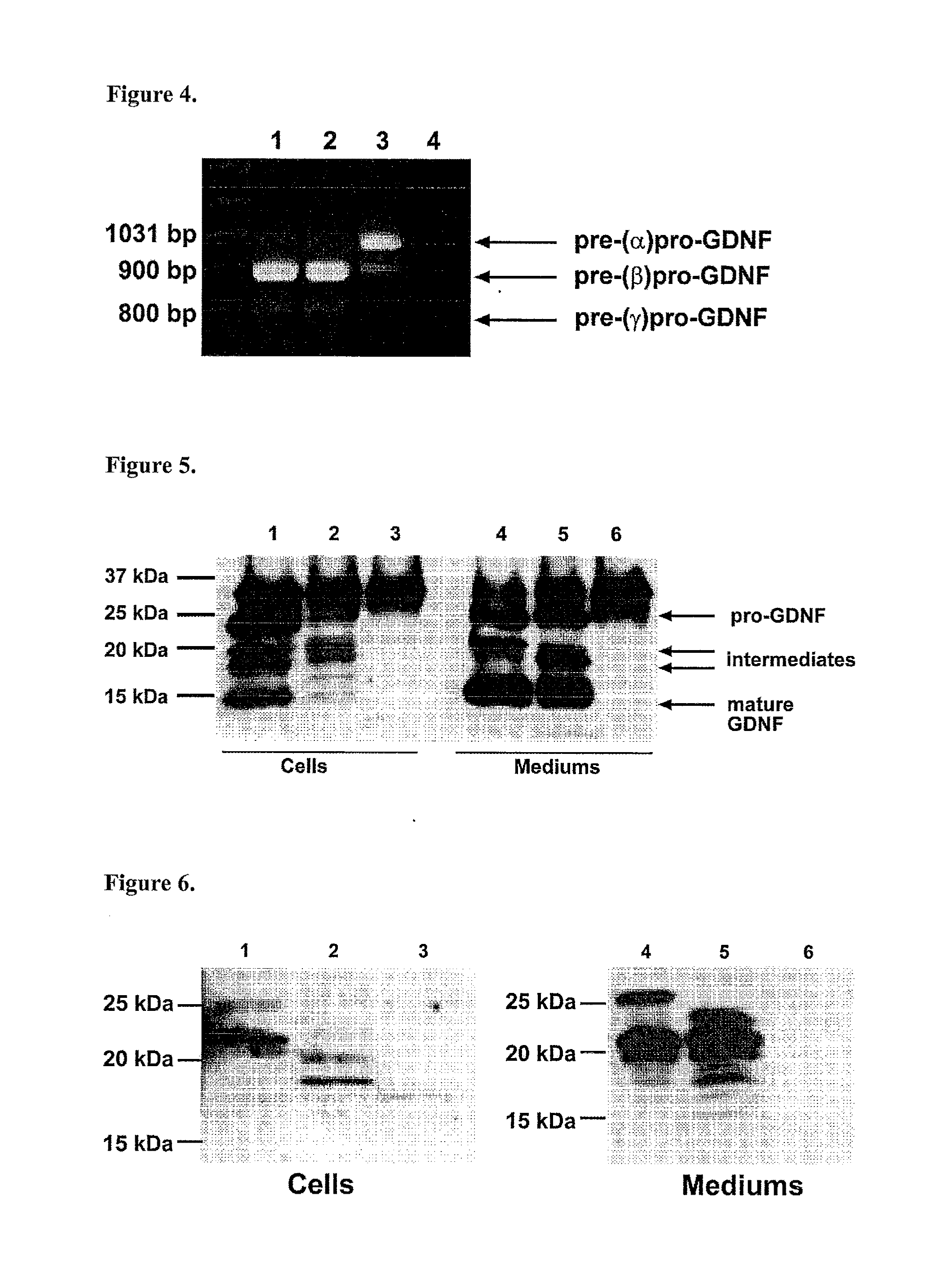Splice variants of gdnf and uses thereof
a glial cell line-derived neurotrophic factor and splice variant technology, applied in the field of splice variants of gdnf protein and its cdna, can solve the problems of potential safety risks and disappointing results of the phase i/ii trial
- Summary
- Abstract
- Description
- Claims
- Application Information
AI Technical Summary
Benefits of technology
Problems solved by technology
Method used
Image
Examples
example 1
Cloning of GDNF Splice Variant cDNAs and Expression Analyses of GDNF Splice Variant mRNAs by RT-PCR
[0145]We cloned pre-(α)pro-GDNF, pre-(β)pro-GDNF and pre-(γ)pro-GDNF cDNAs by RT-PCR from mouse (by using first pair primers 42 and 43 and nested primers 46 and 47) kidney and brain cells as well as from human (by using first pair primers 53 and 49 and nested primers 48 and 54) kidney, uterus and brain cells (FIGS. 3 and 4). Mouse total RNA was isolated using RNA extraction kit (Ambion), human RNAs were obtained from Clontech. First strand cDNAs were synthesized with reverse transcriptase (SuperscriptII, Invitrogen) using oligo(dT) (Promega) primed total RNA (5 μg) from different tissues as a template.
[0146]The primers used in cloning of mouse pre-(α)pro-GDNF, pre-(β)pro-GDNF and pre-(γ)pro-GDNF and human pre-(α)pro-GDNF, pre-(β)pro-GDNF and pre-(γ)pro-GDNF were:
The first primer at the 5′orientation of themouse Gdnf gene (primer 42)5′-GCTCCTGCCCGAGGTC-3′(SEQ ID NO: 7)The first primer a...
example 2
Cell culture
[0154]CHO, HEK-293, PC-6.3 and AtT-20 cell lines were grown in Dulbecco's modified Eagle's medium (DMEM) containing antibiotics together with 10% FCS (Gibco) (CHO and HEK-293 cells), 10% HS (Gibco) and 5% FCS (PC-6.3 cells), 10% FCS, 4.5 g / l glucose and 1.5 g / l sodium carbonate (AtT-20 cells). BHK-21 cell line was grown in Minimum essential medium (MEM) containing antibiotics, 7.5% FCS, 0.04% tryptose phosphate broth (Difco) and 1% glutamate (Gibco). Cells were transfected with pEGFP-N1 (Invitrogen) expression vector containing mouse pre-(α)pro-GDNF, pre-(β)pro-GDNF or pre-(γ)pro-GDNF or human pre-(α)pro-GDNF, pre-(β)pro-GDNF or pre-(γ)pro-GDNF cDNA. Alternatively, cells were transfected with pAAV-MCS or pAAV-IRES-hrGFP vector containing human pre-(α)pro-GDNF, pre-(β)pro-GDNF or pre-(γ)pro-GDNF-ATG cDNA by using Lipofectamine 2000 (Invitrogen) transfection protocol. In Western blot analysis, transfected cells were grown for 48 h in OptiMEM (Sigma) medium followed by coll...
example 3
Secretion of Human pre-(α)pro-GDNF and pre-(β)pro-GDNF from Differentiated PC-6.3 Cells and Hippocampal Primary Cells
Differentiation and Stimulation of PC-6.3 Cells
[0156]After transfection, PC-6.3 cells were grown in differentiation medium containing Dulbecco's modified Eagle's medium (DMEM), 5% HS (Gibco), 2.5% FCS and 50 ng / ml NGF. After 72 h the medium was removed and replaced with serum-free DMEM with or without 50 mM KC1. Expression constructs used in transfections were human and mouse pre-(α)pro-GDNF and pre-(β)pro-GDNF in pEGFP. In ELISA analysis, pEGFP-N1 expression vector (Invitrogen) containing rat pre-pro-BDNF without a stop codon (a gift from Dr. Volkmar Lessman, University of Johannes-Gutenberg, Mainz, Germany) was used as a positive control for activity-dependent secretion (Haubensak et al., J. Cell Sci., 111:1483-93 (1998)). This construct was cloned similarly than other constructs used. In Western blot analysis, the media (supernatant) were collected after 5 h and co...
PUM
| Property | Measurement | Unit |
|---|---|---|
| Nucleic acid sequence | aaaaa | aaaaa |
| Environmental properties | aaaaa | aaaaa |
Abstract
Description
Claims
Application Information
 Login to View More
Login to View More - R&D
- Intellectual Property
- Life Sciences
- Materials
- Tech Scout
- Unparalleled Data Quality
- Higher Quality Content
- 60% Fewer Hallucinations
Browse by: Latest US Patents, China's latest patents, Technical Efficacy Thesaurus, Application Domain, Technology Topic, Popular Technical Reports.
© 2025 PatSnap. All rights reserved.Legal|Privacy policy|Modern Slavery Act Transparency Statement|Sitemap|About US| Contact US: help@patsnap.com



